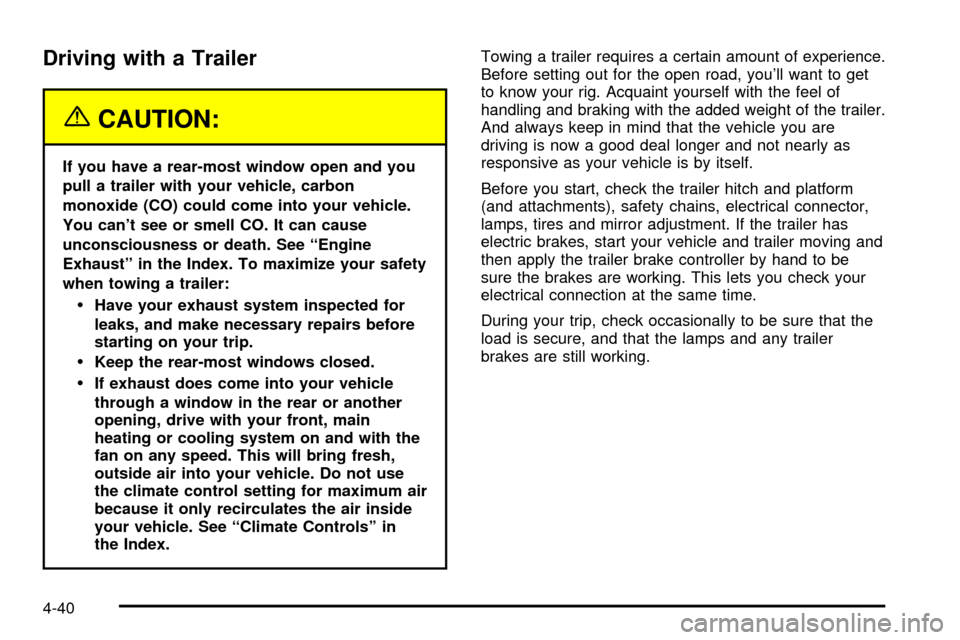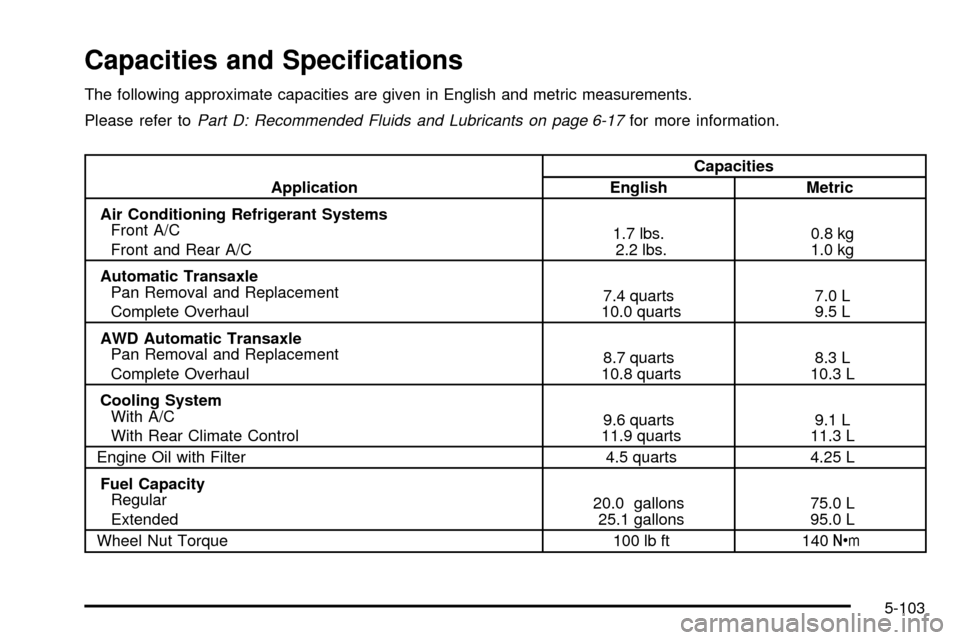2003 CHEVROLET VENTURE climate control
[x] Cancel search: climate controlPage 272 of 486

Compact Disc Messages
CHECK CD:If this message appears on the radio
display, it could be due to one of the following reasons:
·You're driving on a very rough road. When the
road becomes smoother, the disc should play.
·The disc is dirty, scratched, wet or upside down.
·The air is very humid. If so, wait about an hour and
try again.
·There may have been a problem while burning
the CD.
·The label may be caught in the CD player.
If the CD is not playing correctly, for any other reason,
try a known good CD.
If any error occurs repeatedly or if an error can't be
corrected, contact your dealer. If your radio displays an
error message, write it down and provide it to your
dealer when reporting the problem.
Entertainment System
Your vehicle may have an optional Digital Video
Disc (DVD) entertainment system. The entertainment
system works with the vehicle's audio system and
includes a DVD player, a video display screen,
headphones and a remote control. The entertainment
system also integrates the rear climate control and rear
seat audio functions.
Before You Drive
The video entertainment system is for passengers in the
second and third row seats only. The driver cannot
safely view the video screen while driving and should
not try to do so.
In severe or extreme weather conditions your
entertainment system will shut down until the
temperature is within the operating range. This
protection feature will keep your video components from
being damaged while the temperature is below
-4ÉF (-20ÉC) or above 140ÉF (60ÉC). To resume
operation, shut off the entertainment system, pull down
the video screen and then heat or cool the vehicle
until the temperature is within the operating range.
3-92
Page 326 of 486

Driving with a Trailer
{CAUTION:
If you have a rear-most window open and you
pull a trailer with your vehicle, carbon
monoxide (CO) could come into your vehicle.
You can't see or smell CO. It can cause
unconsciousness or death. See ªEngine
Exhaustº in the Index. To maximize your safety
when towing a trailer:
·Have your exhaust system inspected for
leaks, and make necessary repairs before
starting on your trip.
·Keep the rear-most windows closed.
·If exhaust does come into your vehicle
through a window in the rear or another
opening, drive with your front, main
heating or cooling system on and with the
fan on any speed. This will bring fresh,
outside air into your vehicle. Do not use
the climate control setting for maximum air
because it only recirculates the air inside
your vehicle. See ªClimate Controlsº in
the Index.Towing a trailer requires a certain amount of experience.
Before setting out for the open road, you'll want to get
to know your rig. Acquaint yourself with the feel of
handling and braking with the added weight of the trailer.
And always keep in mind that the vehicle you are
driving is now a good deal longer and not nearly as
responsive as your vehicle is by itself.
Before you start, check the trailer hitch and platform
(and attachments), safety chains, electrical connector,
lamps, tires and mirror adjustment. If the trailer has
electric brakes, start your vehicle and trailer moving and
then apply the trailer brake controller by hand to be
sure the brakes are working. This lets you check your
electrical connection at the same time.
During your trip, check occasionally to be sure that the
load is secure, and that the lamps and any trailer
brakes are still working.
4-40
Page 395 of 486

Uniform Tire Quality Grading
Quality grades can be found where applicable on the
tire sidewall between tread shoulder and maximum
section width. For example:
Treadwear 200 Traction AA Temperature A
The following information relates to the system
developed by the United States National Highway
Traffic Safety Administration, which grades tires by
treadwear, traction and temperature performance.
(This applies only to vehicles sold in the United States.)
The grades are molded on the sidewalls of most
passenger car tires. The Uniform Tire Quality Grading
system does not apply to deep tread, winter-type
snow tires, space-saver or temporary use spare tires,
tires with nominal rim diameters of 10 to 12 inches
(25 to 30 cm), or to some limited-production tires.
While the tires available on General Motors passenger
cars and light trucks may vary with respect to these
grades, they must also conform to federal safety
requirements and additional General Motors Tire
Performance Criteria (TPC) standards.
Treadwear
The treadwear grade is a comparative rating based on
the wear rate of the tire when tested under controlled
conditions on a speci®ed government test course.
For example, a tire graded 150 would wear one and
a half (1.5) times as well on the government course as
a tire graded 100. The relative performance of tires
depends upon the actual conditions of their use,
however, and may depart signi®cantly from the norm
due to variations in driving habits, service practices and
differences in road characteristics and climate.
Traction ± AA, A, B, C
The traction grades, from highest to lowest, are AA, A,
B, and C. Those grades represent the tire's ability
to stop on wet pavement as measured under controlled
conditions on speci®ed government test surfaces of
asphalt and concrete. A tire marked C may have poor
traction performance. Warning: The traction grade
assigned to this tire is based on straight-ahead braking
traction tests, and does not include acceleration,
cornering, hydroplaning, or peak traction characteristics.
5-65
Page 433 of 486

Capacities and Speci®cations
The following approximate capacities are given in English and metric measurements.
Please refer to
Part D: Recommended Fluids and Lubricants on page 6-17for more information.
ApplicationCapacities
English Metric
Air Conditioning Refrigerant Systems
Front A/C
Front and Rear A/C1.7 lbs.
2.2 lbs.0.8 kg
1.0 kg
Automatic Transaxle
Pan Removal and Replacement
Complete Overhaul7.4 quarts
10.0 quarts7.0 L
9.5 L
AWD Automatic Transaxle
Pan Removal and Replacement
Complete Overhaul8.7 quarts
10.8 quarts8.3 L
10.3 L
Cooling System
With A/C
With Rear Climate Control9.6 quarts
11.9 quarts9.1 L
11.3 L
Engine Oil with Filter 4.5 quarts 4.25 L
Fuel Capacity
Regular
Extended20.0 gallons
25.1 gallons75.0 L
95.0 L
Wheel Nut Torque 100 lb ft 140Y
5-103
Page 472 of 486

Cleaning Glass Surfaces..................................5-89
Cleaning Interior Plastic Components.................5-89
Cleaning Leather............................................5-89
Cleaning the Top of the Instrument Panel...........5-89
Cleaning Tires................................................5-92
Cleaning Vinyl................................................5-89
Cleaning Windshield, Backglass and
Wiper Blades..............................................5-92
Cleaning........................................................5-87
Inside of Your Vehicle..................................5-87
Outside of Your Vehicle................................5-90
Underbody Maintenance...............................5-93
Video Screen............................................3-105
Weatherstrips..............................................5-90
Your DVD Player.......................................3-105
Climate Control System...................................3-25
Air Filter, Passenger Compartment.................3-33
Outlet Adjustment........................................3-28
Rear..................................................3-29, 3-31
Compact Disc Messages.................3-71, 3-81, 3-92
Compact Overhead Console.............................2-52
Compact Spare Tire........................................5-86
Compass Variance..........................................3-59
Content Theft-Deferrent....................................2-27
Content Theft-Deterrent System,
Arming and Disarming..................................2-68
Content Theft-Deterrent System........................2-67Control of a Vehicle.......................................... 4-5
Convenience Center........................................2-58
Convenience Net............................................2-57
Coolant.........................................................3-44
Engine Temperature Gage............................3-44
Engine Temperature Warning Message...........3-51
Heater, Engine............................................2-33
Cooling System..............................................5-29
Cruise Control................................................3-11
Cupholder(s)..................................................2-51
Current and Past Model Order Forms................7-11
Customer Assistance Information........................ 7-7
Courtesy Transportation.................................. 7-7
Customer Assistance for Text Telephone
(TTY) Users.............................................. 7-4
Customer Assistance Offices........................... 7-4
Customer Satisfaction Procedure..................... 7-2
GM Mobility Program for Persons with
Disabilities................................................ 7-5
Reporting Safety Defects to General Motors....7-10
Reporting Safety Defects to the Canadian
Government............................................7-10
Reporting Safety Defects to the United
States Government.................................... 7-9
Roadside Assistance Program......................... 7-6
Service Publications Ordering Information........7-10
4
Page 481 of 486

Radios (cont.)
Theft-Deterrent..........................................3-103
Understanding Reception............................3-104
RDS Messages..............................3-68, 3-76, 3-86
Rear Climate Control System...................3-29, 3-31
Rear Hatch Ajar Warning Message....................3-56
Rear Reading Lamps......................................3-20
Rear Safety Belt Comfort Guides......................1-52
Rear Seat Audio (RSA)..........................3-99, 3-101
Rear Seat Operation......................................... 1-7
Rear Seat Outside Passenger Positions.............1-49
Rear Seat Passengers, Safety Belts..................1-48
Rear Seat Radio Controls.....................3-100, 3-102
Rear Storage Area..........................................2-57
Rear Window Defogger....................................3-28
Rearview Mirrors.............................................2-44
Reclining Seatbacks.......................................... 1-4
Recreational Vehicle Towing.............................4-32
Remote Alarm.................................................. 2-7
Remote Control..............................................3-97
Remote Driver Unlock Control...........................2-65
Remote Keyless Entry System, Operation............ 2-6
Remote Keyless Entry System............................ 2-5
Remote Lock and Unlock Con®rmation...............2-66
Remote Power Sliding Door Operation................. 2-7
Removing the Bucket Seats.............................1-18
Removing the Captain's Chairs.........................1-23
Removing the Child from the Built-In Child
Restraint....................................................1-90
Removing the Convenience Center....................2-59Removing the Flat Tire and Installing the
Spare Tire..................................................5-77
Removing the Spare Tire and Tools...................5-72
Removing the Split Bench Seat........................1-11
Removing the Stowable Seat............................1-27
Removing the Wheel Covers............................5-77
Replacement Bulbs.........................................5-57
Replacing Brake System Parts..........................5-43
Replacing Restraint System Parts
After a Crash............................................1-104
Replacing the Bucket Seats..............................1-20
Replacing the Captain's Chairs.........................1-24
Replacing the Convenience Center....................2-59
Replacing the Split Bench Seats.......................1-12
Replacing the Stowable Seat............................1-28
Reporting Safety Defects.................................7-10
Canadian Government..................................7-10
General Motors...........................................7-10
United States Government.............................. 7-9
Reprogramming a Single HomeLink
žButton.......2-51
Resetting Defaults...........................................2-51
Resetting the Power Sliding Door......................2-21
Restraint System Check...................................6-11
Checking Your Restraint Systems.................1-103
Replacing Restraint System Parts
After a Crash.........................................1-104
Restraint Systems.........................................1-103
Checking..................................................1-103
Replacing Parts.........................................1-104
Retained Accessory Power (RAP)......................2-32
13